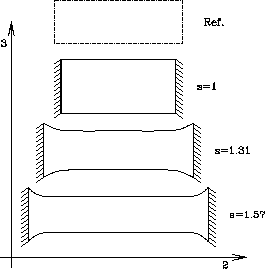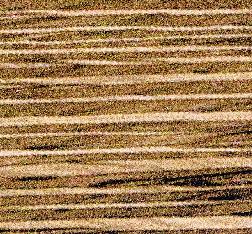
Nematic elastomers: Experiments and geometry |

Experimental geometry.
In the initial configuration the director is vertical. Uniform displacements in direction 2 on the two faces with normal e2 (thicker lines) are then prescribed. The rest of the boundary is free, and the out-of-plane component of the displacement is free for the entire sample. The stretch s is defined as the ratio between the deformed and the original length of the sample in direction 2.
This stretching procedure influences the director. Its orientation is
vertical in the initial state, and horizontal in the final, highly
stretched state. In the intermediate states the orientation is not
uniform throughout the sample, but exhibits a characteristic layered
texture, which corresponds to the lamination construction used to
compute the quasicoinvex envelope of the energy.

Experimental observation by Kundler and Finkelmann of stripes in the
central region of the sample at moderate stretches. The light and dark
areas correspond to transparent and opaque regions under polarized
light transmission, and have different director orientation. Picture:
Courtesy of I. Kundler and
![[External link]](experiment_files/extlink.gif) H. Finkelmann,
Institut für Makromolekulare
Chemie, Freiburg.
The entire sample is around 10 millimeters long, and 0.3 millimeter
thick. The width of the domains is about 1 to 10 micrometers.
H. Finkelmann,
Institut für Makromolekulare
Chemie, Freiburg.
The entire sample is around 10 millimeters long, and 0.3 millimeter
thick. The width of the domains is about 1 to 10 micrometers.
Forward:
Results